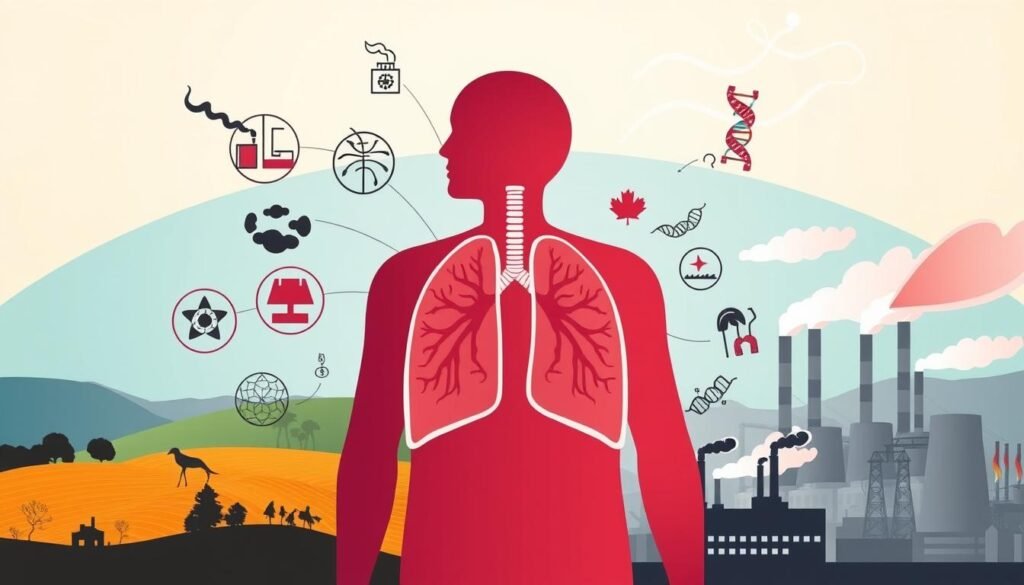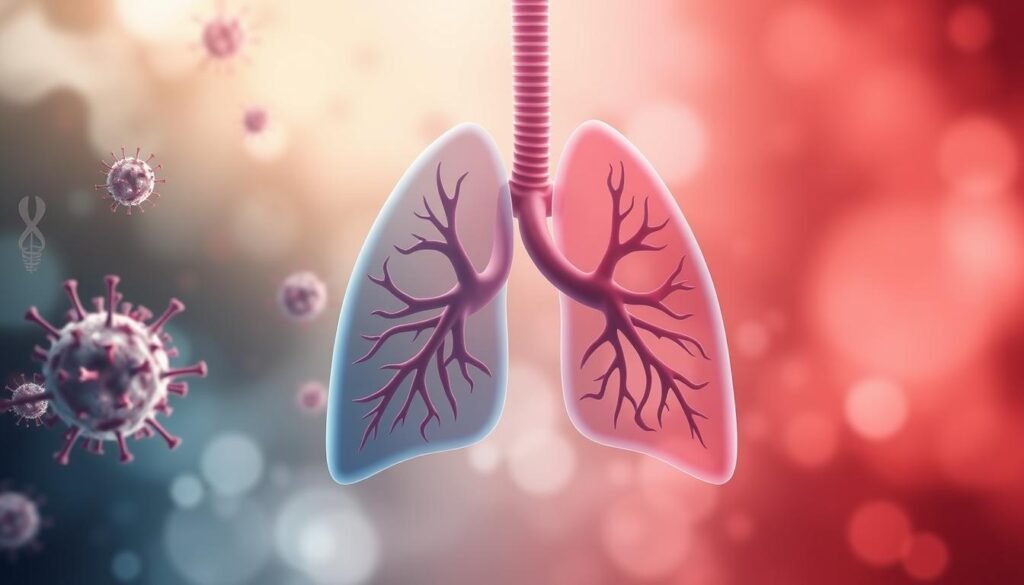Did you know that people with asthma are 1.36 times more likely to get cancer? More than 25 million Americans live with asthma. Many do not know it can lead to lung cancer.
Studies have focused on asthma and lung cancer. Asthma can change health outcomes as people get older. This article looks at how asthma and lung cancer are connected.
A study at the University of Florida found a strong link between asthma and cancer. Some with asthma might not see how it’s linked to their cancer risk.
Inhaled steroids might protect against some cancers. Managing asthma well could reduce these risks. This article explores asthma and lung cancer, important for healthcare talks.
Key Takeaways
- The prevalence of asthma in the U.S. is significant, with over 25 million affected individuals.
- Asthma increases the risk of lung cancer and other comorbidities, requiring thorough health management.
- The potential protective benefits of inhaled steroids emphasize the need for effective asthma care.
- Research is ongoing to understand how asthma and lung cancer are connected.
- Grasping this comorbidity can lead to better patient care.
- Healthcare providers should keep an eye on asthma patients for cancer risks.
Understanding Asthma and Its Implications for Health
A growing understanding of asthma shows its big effects on health and life. This disease causes swelling in the airways, leading to symptoms that disturb daily life. Knowing these signs helps people get the right treatment and manage their asthma better.
Definition and Symptoms of Asthma
Asthma is known for causing chronic swelling in the airways. This brings about symptoms like:
- Wheezing
- Chest tightness
- Shortness of breath
- Coughing, especially at night or in the morning
The seriousness of asthma varies from person to person. Some may have mild symptoms, while others have frequent issues. Things like allergens and pollution can trigger these symptoms. This can cause a lot of discomfort and limit daily activities.
Impacts of Asthma on Daily Life
Asthma does more than just affect your physical health. It can limit doing things you enjoy, like sports or being outdoors. It often makes people feel alone and stressed, especially if their asthma is severe. Having this constant swelling also ups the risk for other health problems. That’s why it’s key to manage asthma well to stay active and healthy.
| Impact on Daily Life | Frequency of Affected Individuals |
|---|---|
| Difficulty in Physical Activities | 75% of patients |
| Work Productivity Decline | 60% of patients |
| Social Isolation | 40% of patients |
| Emotional Distress | 55% of patients |
Understanding these impacts is crucial for creating treatments and support that improve life for those with asthma. This leads to better health in the long run.
The Connection Between Asthma and Lung Cancer
The link between asthma and lung cancer is a key area of study. Understanding how cancer affects people with asthma sheds light on both conditions. People with asthma are at a higher risk of getting lung cancer than those without it.
Research Findings on Lung Cancer Incidence in Asthmatic Patients
Research shows that asthma patients have a higher cancer rate—383.02 per 100,000 persons each year. This is in sharp contrast to 139.01 per 100,000 persons among those without asthma. It’s been found that 2% of those with asthma are diagnosed with cancer, notably lung cancer. Asthma patients often wait longer for a cancer diagnosis, sometimes up to 36.6 years.
Inflammation as a Shared Pathway in Both Conditions
Chronic inflammation links asthma and lung cancer. In asthmatic people, ongoing inflammation might change surrounding tissues. This could make them more likely to develop cancer. It particularly affects those with respiratory conditions. Knowing this helps doctors watch for lung cancer signs early in asthmatic patients.

Asthma as a Comorbidity with Other Lung Cancer Risk Factors
Asthma often occurs with other lung cancer risk factors. It’s important to understand how these factors interact. This knowledge helps people with asthma face additional health issues.
Tobacco Smoking and its Impact on Asthmatics
Smoking tobacco is a major risk that worsens asthma. People with asthma who smoke face more severe respiratory problems. This can lead to a higher chance of getting lung cancer. Smoking and asthma together increase inflammation and damage in the lungs.
This link between asthma and smoking needs immediate attention. It could change public health plans. These plans aim to lower the numbers of both asthma and lung cancer cases.
The Role of Air Pollution in Asthma and Lung Cancer Risk
Air pollution is another key factor for asthma and lung cancer risk. It makes asthma symptoms worse and affects overall lung health. Studies show that long-term exposure to pollution raises lung cancer rates, especially for those with asthma.
We need to improve air quality to help people with asthma. Better air quality can reduce both asthma problems and lung cancer risks.
Genetic Predisposition to Both Conditions
Genetics also matter in asthma and lung cancer. Some genes can make asthma worse and increase lung cancer risks. Research is looking into how genetic changes affect our immune response and inflammation.
Continuing to study these genetics could lead to personalized treatment. This would help people at high risk due to their genes.

| Risk Factor | Impact on Asthma | Impact on Lung Cancer Risk |
|---|---|---|
| Tobacco Smoking | Exacerbates symptoms | Increases susceptibility |
| Air Pollution | Worsens respiratory health | Elevates risk due to exposure |
| Genetic Predisposition | Increases severity | Heightens risk of development |
The Role of Chronic Obstructive Pulmonary Disease (COPD)
COPD is a big health issue, especially when it comes with asthma. These diseases can worsen each other’s symptoms, making treatment harder. Knowing how they interact is important, given the possible increase in lung cancer risk.
How COPD Interacts with Asthma Among Patients
Having both COPD and asthma changes how doctors look at these conditions. COPD can make asthma worse and lower lung function. This makes it hard to manage these diseases, leading to more doctor visits. People with both conditions often have similar symptoms, which complicates tracking and treating them.
Effects of Comorbid COPD on Lung Cancer Risk
Studies show a scary link between COPD and a higher chance of lung cancer. Having both diseases together increases the risk of getting lung cancer. Smokers with COPD are six times more likely to get lung cancer than those without lung problems. Knowing this link shows why it’s vital to check for and manage both conditions early. For more info, visit this resource.

Occupational Exposure as a Risk Factor
Occupational exposure is a big risk factor for asthma and lung cancer. Many jobs expose people to dangerous substances that harm the lungs and can increase the risk of cancer. This is common in construction, manufacturing, and chemical processing, where carcinogenic agents are present.
Common Occupations Associated with Increased Risk
Some workers face more hazards on the job, leading to higher lung cancer risk and more asthma problems. This includes:
- Construction workers
- Manufacturing employees
- Chemical plant workers
- Shipyard workers
Studies show asthma gets worse from dust or fumes in these jobs. About 10% of workers are exposed to dust. It’s important to be careful to avoid breathing problems.
The Synergistic Effect of Asthma and Occupational Hazards
The mix of asthma and workplace hazards can really increase lung cancer risk. People with asthma working with dangerous substances can have more lung inflammation and damage. Asthma is over two times more common in those who have been exposed at work. Wearing protection at work can help keep lungs healthy, reducing asthma and cancer risks. Scientists are studying more about how these factors interact, like in recent research.
Addressing the Challenges of Diagnosis
Distinguishing between asthma and lung cancer symptoms presents significant diagnosis challenges. Both conditions show similar symptoms like persistent coughing and shortness of breath. This makes it hard to pinpoint the correct diagnosis. Often, people with asthma might ignore severe symptoms, thinking they’re just part of their condition. This delay can prevent them from getting the cancer treatment they need. Doctors should always be alert for signs of lung cancer in patients with long-term respiratory issues.
Differentiating Symptoms of Asthma and Lung Cancer
It’s crucial to know the asthma symptoms that are different from lung cancer signs. Asthma often leads to wheezing, while lung cancer might cause more severe coughing and weight loss. Recognizing these differences can lead to better care and monitoring. For more insight, resources like differentiating allergy and lung cancer symptoms are very helpful.
The Importance of Early Detection in Asthmatic Patients
Early detection of lung cancer can greatly increase the chances of successful treatment. However, only 5.8% of those who should get screened actually do, based on recommendations from the United States Preventive Services Task Force. This is much lower than breast cancer screenings, which have a 76% rate. This big difference shows we need to push for more lung cancer screening awareness and support.
Patients with asthma should not ignore serious symptoms or delay getting screened. Quick action and regular monitoring are crucial for good health and getting the right treatment. Since 2015, Medicare has encouraged early screening and careful decision-making.
Management and Treatment Strategies
Managing asthma well is key to lowering lung cancer risk and improving health. With asthma affecting about 357.4 million people, it’s important to have a solid plan. This plan should improve medication use, like inhaled corticosteroids and bronchodilators. It also includes lifestyle changes to lessen risk factors.
Effective Asthma Control to Mitigate Risk
A hands-on approach to controlling asthma helps cut down risks. Tailored treatment plans also focus on avoiding smoke and pollutants. Quitting smoking is a big step, as it greatly raises lung cancer risks for those with asthma.
Therapeutic Approaches for Patients with Comorbidities
Patient care for those with asthma and other issues, like COPD, needs to be specific. Doctors from respiratory, cancer, and primary care fields must work together. Their goal is to manage asthma considering other health issues, reduce inflammation, and lower health risks. Cutting-edge treatments provide wide-ranging benefits. To learn more about asthma, COPD, and lung cancer, check out this article.
| Treatment Component | Goal | Examples |
|---|---|---|
| Medication Optimization | Control asthma symptoms | Inhaled corticosteroids, bronchodilators |
| Environmental Management | Reduce exposure to triggers | Air filtration systems, avoiding smoke |
| Lifestyle Changes | Enhance overall health | Smoking cessation, exercise |
| Coordinated Care | Address comorbidities | Integrated treatment plans |
Current Research and Future Directions
Research today is studying how asthma and lung cancer are connected. Scientists are looking into what increases cancer risk in people with asthma. This topic is key for researchers trying to find out why cancer is more common in asthmatics.
For example, a study found that people with asthma have a higher rate of getting cancer. They found 383.02 cases of cancer per 100,000 people with asthma. This is much more than the 139.01 cases in people who don’t have asthma.
Ongoing Studies on the Asthma-Lung Cancer Link
Some cancers, like lung cancer, are found more often in people with asthma. Asthmatics usually get a lung cancer diagnosis later than others, after about 36.6 years. These findings show the urgent need for research. It’s important to understand how asthma, inflammation, and genetics can lead to lung cancer.
Importance of Comprehensive Patient Care
It’s crucial to take care of asthma patients by looking at all their health needs. Doctors should educate them about the risks of asthma and other related health issues. They should also check for lung cancer risks, especially in patients with severe asthma symptoms.
This care helps find cancer early and manage it better, leading to better health outcomes for the patient. It’s vital to watch closely and care for each patient’s needs. This way, we can improve the lives of those with asthma and lower their chances of getting lung cancer.
Conclusion
The link between asthma and lung cancer is complex. Studies show asthma patients are more likely to get cancer. Those without asthma have a lower chance, with a risk difference noted at 1.36.
Not using inhaled steroids raises this risk to 1.60. This highlights why managing asthma is crucial. It helps lower the chance of lung cancer and other serious diseases.
Asthma combined with other health issues like COPD adds to lung cancer risks. It’s vital to tackle these conditions with proper diagnosis and treatment. This approach can lead to better patient outcomes. Being aware and acting upon asthma as a risk factor for lung cancer is key.
Future research will shed more light on asthma and lung cancer’s ties. This means healthcare providers should watch asthma patients closely. By knowing the increased risk, they can focus on asthma care. And help prevent lung cancer too.